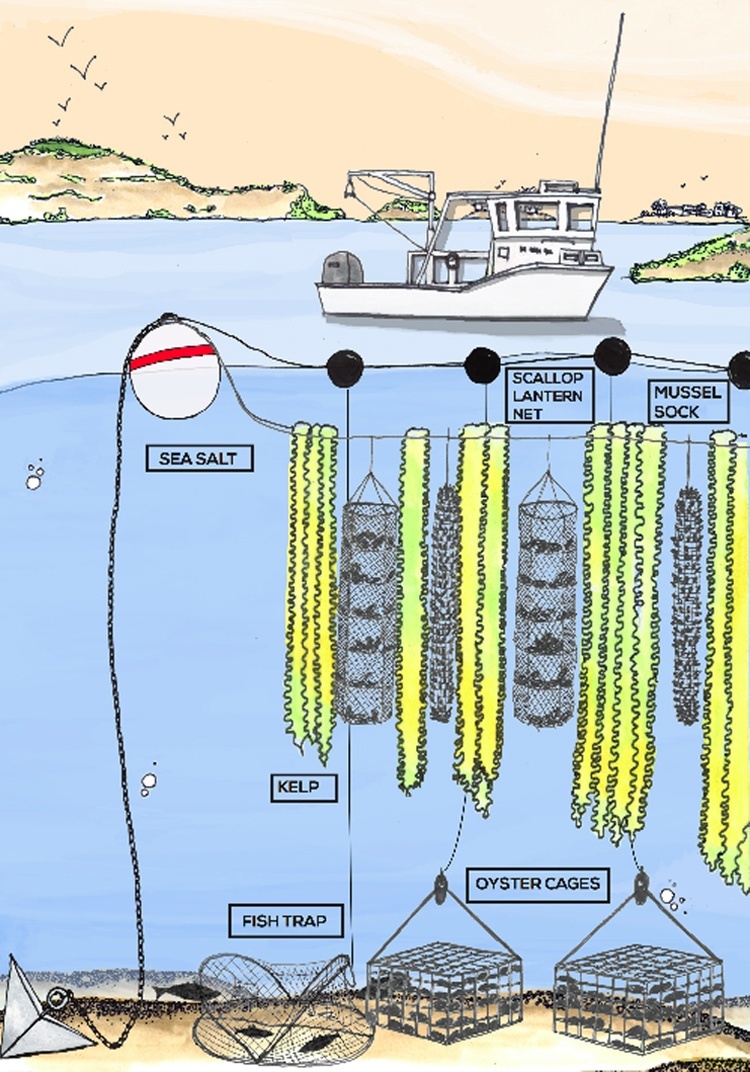
What do you expect from an epileptic, asthmatic fisherman who doesn’t know swimming, was dropped out of high school, and who spent most of his nights in jails? Wisdom. Invention. Vision.
Meet Bren Smith, executive director of nonprofit GreenWave, who has developed a new method of vertical ocean farming designed to restore ocean ecosystems, mitigate climate change, and create blue-green jobs for fishermen — while providing healthy, local food for communities.
Smith’s restorative 3D ocean farming system — which only grows restorative crops, such as seaweed and shellfish, to produce food, fertilizer, animal feed, cosmetics and bio-fuel — was awarded the 2015 Buckminster Fuller Challenge, one of the most important prizes in sustainability.
Smith, who is now trying to help spread his idea to ocean farmers across the globe by open-sourcing the model, shares his story of “ecological redemption”:
“At age 14 I left school and headed out to sea. I fished the Georges Banks and the Grand Banks for tuna and lobster, then headed to the Bering Sea, where I fished cod and crab. The trouble was I was working at the height of the industrialization of food. We were tearing up entire ecosystems with our trawls, chasing fish further and further out to sea into illegal waters. I personally have thrown tens of thousands of pounds of by-catch back into the sea.
“It wasn’t just that we were pillaging. Most of my fish was going to McDonald’s for their fish sandwiches. There I was, still a kid, working one of the most unsustainable forms of food production on the planet, producing some of the most unhealthy food on the planet.
“For a long time I’d seen climate change only as an environmental issue because environmentalists were always framing it in terms of birds, bears, and bees, but I’m a fisherman. I kill things for a living. I grew up shooting moose out of my kitchen window. I never thought climate change had anything to do with my life. But it does. From my vantage point, climate change is not an environmental issue at all — it’s an economic issue.
“Our 3D farms are designed to address three major challenges: First, to bring to the table a delicious new seafood plate in this era of overfishing and food insecurity; second, to transform fishermen into restorative ocean farmers; and third, to build the foundation for a new blue-green economy that doesn’t recreate the injustices of the old industrial economy.”
According to The Guardian, each of Smith’s ocean farms includes hurricane-proof anchors on the edges. Within its boundaries, seaweed, mussels and scallops hang from floating ropes. Oysters grow in cages below the ropes, and cages of clams hang beneath them. The hanging farms also harvest salt.
A single acre of 3D farm filters millions of gallons of ocean water every day, creates homes for hundreds of wild marine and bird species, and absorbs the overabundance of nitrogen (oysters filter 50 gallons of water a day) and carbon (Kelp soaks up five times as much carbon as land-based plants) that are killing billions of organisms. The design requires zero-inputs—there is no need for fresh water or fertilizer.
#ocean #green #farm #science #energy #sea How underwater 3D farms could revolutionize food production https://t.co/Ui9xtR0TrD #GenerationNow
— SK Watermakers (@SKWatermakers) April 21, 2016
Smith says his model farms are capable of producing 30 times more bio-fuel than soybeans and five times more bio-fuel than corn — without polluting the food chain.
“I think it allows us to take the crisis of climate change and flip it into an opportunity to really innovate in sustainable ways. Anybody with 20 acres, a boat and $30,000 can start a farm and be up and running within a year.”
This article (Fisherman Invents 3D Ocean Farms that Only Grow Restorative Crops) is a free and open source. You have permission to republish this article under a Creative Commons license with attribution to the author and AnonHQ.com.





